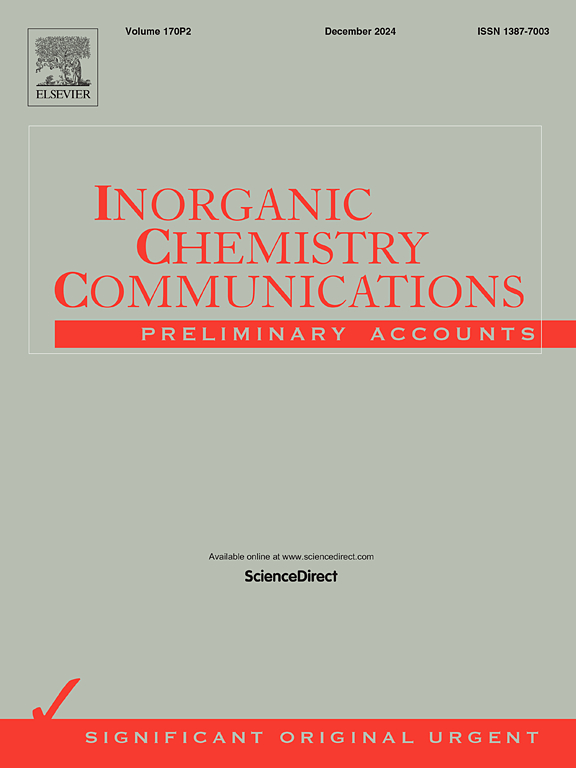基于agbio3的环境可持续性异质结的进展:修饰策略和机制见解
IF 4.4
3区 化学
Q1 CHEMISTRY, INORGANIC & NUCLEAR
引用次数: 0
摘要
研究界一直致力于以半导体为基础的光催化,以支持下一代的环境可持续生活。铋酸银(AgBiO3)是一种具有钛铁矿(钙钛矿结构)的n型铋基光催化剂,具有显著的可持续应用能力。由于AgBiO3光催化剂无毒且元素丰富(Ag, Bi, O),因此被认为是传统光催化剂的环保替代品。在AgBiO3光催化剂中,Bi3+和Bi5+混合价态的存在使带隙缩小,有利于更宽的光吸收范围。然而,裸AgBiO3具有e - /h+对复合快、易发生光腐蚀等缺点,限制了其光催化性能,制约了其实际应用。为了克服这些限制,异质结的形成(ii型、z型和s型)和缺陷的产生通过增强光吸收、提高量子效率、改善电荷转移和减少电荷重组,在提高裸AgBiO3光效方面发挥了不可或缺的作用,EIS和PL光谱验证了这一点。因此,本文就agbio3异质结在光催化领域的最新进展作一综述。它首先概述了电子、光学和晶体学性质,并简要讨论了表征技术。然后深入研究了ii型异质结、z型异质结和s型异质结的修饰策略。此外,还探讨了agbio3基异质结在各种有害污染物降解中的作用,从而为可持续发展目标SDG 6(清洁水和卫生)做出贡献。最后,对未来的研究方向进行了展望,并对主要发现进行了总结。本文章由计算机程序翻译,如有差异,请以英文原文为准。

Advancements in AgBiO3-based heterojunctions for environmental sustainability: Modification strategies and mechanistic insights
The research fraternity has focused on semiconductor-based photocatalysis to support environmentally sustainable living for upcoming generations. Silver bismuthate (AgBiO3), a potential n-type bismuth-based photocatalyst with ilmenite (perovskite structure) offers remarkable ability for sustainable application. Owing to non-toxic and earth-abundant elements (Ag, Bi, O), the AgBiO3 photocatalyst is considered to be an eco-friendly alternative to traditional photocatalysts. The presence of mixed valence states Bi3+ with a filled 6 s orbital and Bi5+ with an empty 6 s orbital in AgBiO3 photocatalyst narrows the band gap and facilitates a broader light absorption range. However, bare AgBiO3 exhibits some disadvantages like fast e–/h+ pair recombination and is prone to photo-corrosion, which limits its photocatalytic performance and restricts its practical utility. To overcome these limitations, heterojunction formation (Type-II, Z-scheme, and S-scheme) and defect generation play an indispensable role in boosting the photo-efficiency of the bare AgBiO3 via enhanced light absorption, higher quantum efficiency, improved charge transference, and reduced charge recombination as validated by EIS and PL spectroscopy. Therefore, our review focuses on the latest advancements in AgBiO3-based heterojunctions in the field of photocatalysis. It begins with an overview of electronic, optical, and crystallographic properties with a brief discussion of characterization techniques. The review then delves into the modification strategies including type-II, Z-scheme, and S-scheme heterojunction with mechanistic insight. Moreover, the role of AgBiO3-based heterojunctions for various noxious pollutant degradation was explored, thereby contributing to sustainable development goals SDG 6 (Clean Water and Sanitation). Lastly, this article outlines some future research directions and concludes with a summary of key findings.
求助全文
通过发布文献求助,成功后即可免费获取论文全文。
去求助
来源期刊

Inorganic Chemistry Communications
化学-无机化学与核化学
CiteScore
5.50
自引率
7.90%
发文量
1013
审稿时长
53 days
期刊介绍:
Launched in January 1998, Inorganic Chemistry Communications is an international journal dedicated to the rapid publication of short communications in the major areas of inorganic, organometallic and supramolecular chemistry. Topics include synthetic and reaction chemistry, kinetics and mechanisms of reactions, bioinorganic chemistry, photochemistry and the use of metal and organometallic compounds in stoichiometric and catalytic synthesis or organic compounds.
 求助内容:
求助内容: 应助结果提醒方式:
应助结果提醒方式:


